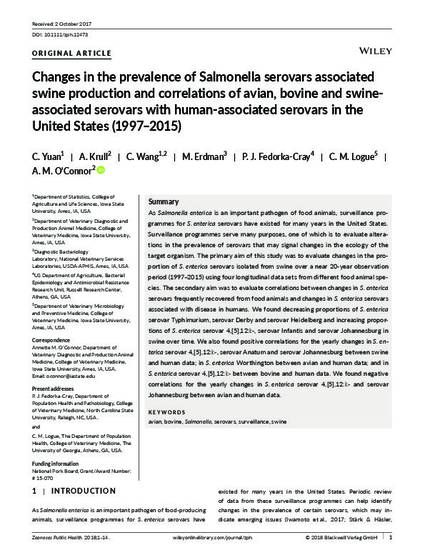
As Salmonella enterica is an important pathogen of food animals, surveillance programmes for S. enterica serovars have existed for many years in the United States. Surveillance programmes serve many purposes, one of which is to evaluate alterations in the prevalence of serovars that may signal changes in the ecology of the target organism. The primary aim of this study was to evaluate changes in the proportion of S. enterica serovars isolated from swine over a near 20‐year observation period (1997–2015) using four longitudinal data sets from different food animal species. The secondary aim was to evaluate correlations between changes in S. enterica serovars frequently recovered from food animals and changes in S. enterica serovars associated with disease in humans. We found decreasing proportions of S. enterica serovar Typhimurium, serovar Derby and serovar Heidelberg and increasing proportions of S. enterica serovar 4,[5],12:i:‐, serovar Infantis and serovar Johannesburg in swine over time. We also found positive correlations for the yearly changes in S. enterica serovar 4,[5],12:i:‐, serovar Anatum and serovar Johannesburg between swine and human data; in S. enterica Worthington between avian and human data; and in S. enterica serovar 4,[5],12:i:‐ between bovine and human data. We found negative correlations for the yearly changes in S. enterica serovar 4,[5],12:i:‐ and serovar Johannesburg between avian and human data.
Available at: http://works.bepress.com/annette_oconnor/78/

This article is published as Yuan, C., A. Krull, C. Wang, M. Erdman, P. J. Fedorka‐Cray, C. M. Logue, and A. M. O'Connor. "Changes in the prevalence of Salmonella serovars associated swine production and correlations of avian, bovine and swine‐associated serovars with human‐associated serovars in the United States (1997–2015)." Zoonoses and Public Health (2018). DOI: 10.1111/zph.12473. Posted with permission.